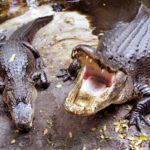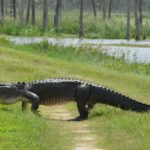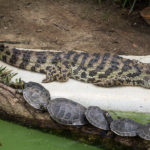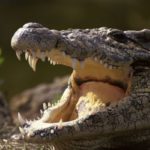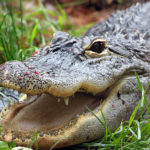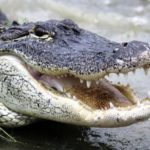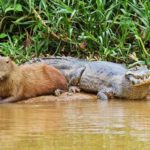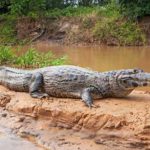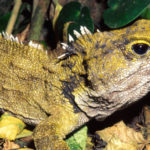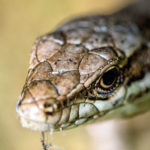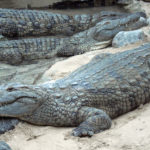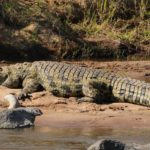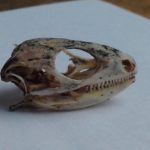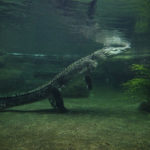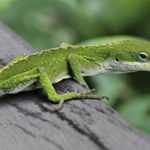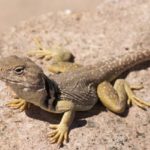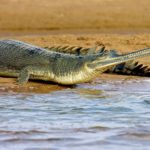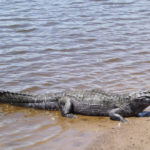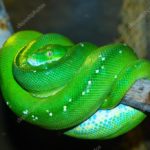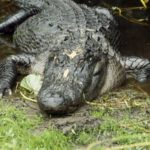Alligator – description and species
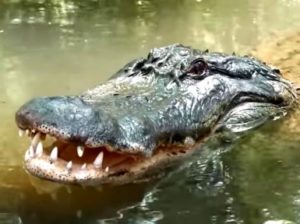 An alligator is an animal that usually causes fear in humans. But at the same time, many relate to him with interest, which is natural since alligators lead their own, special way of life, not at all like the lives of other animals.
An alligator is an animal that usually causes fear in humans. But at the same time, many relate to him with interest, which is natural since alligators lead their own, special way of life, not at all like the lives of other animals.
Alligators, like their closest relatives, crocodiles and caimans, look like enlarged lizards. All of them belong to the class of reptiles or reptiles, direct descendants of the largest animals – dinosaurs.
Alligator – a huge reptile more than 3 meters long and weighing several hundred kilograms, perfectly feeling both in water and on land. This is one of the most bloodthirsty predators eating exclusively animal food, capable of almost instantly killing not only a large animal, but also a person. Alligators and crocodiles look very similar to each other, and so much so that an uninformed person is unlikely to be able to distinguish them. And this is not surprising, because crocodiles and alligators are reptiles belonging to the order of aquatic vertebrates that have lived on the earth for several million years. Of course, their ancient ancestors were much larger, but at that time all the animals on earth were enormous in size and only the ice age stopped their development.
Reptiles managed to survive mainly because their aquatic environment has not changed significantly over millions of years. This also explains their external similarity, although there is a difference. The crocodile’s face is sharp and with its jaws closed, a fourth tooth protruding outward is visible. The alligator’s face is dumber. Crocodiles are slightly larger in size than alligators. And crocodiles and alligators are cold-blooded animals, his body temperature is about 30 degrees.
The body of alligators for protection is covered with dense bone plates. Alligator front legs are shorter and have five fingers, four fingers on the hind legs. The mouth of the alligator is huge and powerful. It contains from 74 to 84 teeth. Moreover, if a tooth is lost for some reason, then after a while it grows back.
The color of alligators is dark and depends on the color of the reservoir. If there are a lot of algae in the water where they live, then they have a greenish color. In marshy places where there is a lot of tannic acid in the water, the belly has a light brown, almost cream color. In muddy water they are brown, sometimes almost black.
The eyes are small, greenish-yellow in color, with vertical pupils, protected by bony shields and therefore the gator’s gaze reflects a metallic luster. At night, in large individuals, the eyes shine in red, in small individuals in green, by this sign you can find an alligator in the dark. The alligator is not a fish, it breathes lightly, but constantly living in water, the alligator will never choke. On top of the nostrils there are special folds of skin that tightly close the nostrils when dropped into the water.
The main tool of the alligator is a large, flexible and strong tail. It is almost half the length of the body. The tail alligator is operated as a universal tool. Tail is the main means of swimming and a powerful weapon in the fight. With his tail, like a shovel, he makes nests. Moreover, the tail is the largest in the body of the alligator storage of fat stores for the winter. Alligators are excellent swimmers, afloat they use their powerful tail like a rowing oar. On land, they also move quite quickly. Over short distances, they can reach speeds of up to 20 km / h.
Reptiles feed on everything they can catch, these are any animals and fish, fruits and leaves of plants. Young ones feed on snails, crustaceans, turtles and insects. Adults prefer large prey. They hunt raccoons, platypuses, skunks, deer, wild pigs, cows and even small bears. They have a peculiar tactics of hunting. They can wait for hours, hiding in the water, so that only eyes and nostrils peer out onto the surface.
When the prey is nearby, the alligator rushes forward due to its tail strike, grabs an unsuspecting animal with its huge mouth and drags it from the shore. Rotating around its axis, it drowns it in water, and then tears the carcass into parts, presses with jaws and swallows in large pieces. Alligators swallow small animals such as muskrats, nutria, dogs, rats and birds. Turtles, snakes and lizards also go into business. They crumble hard shells with their teeth. An alligator can wait for hours, and attack and drown in just a few seconds. In famine, they do not disdain carrion. They usually hunt at night, and during the day they either bask in the sun or sleep in burrows.
The Mississippi alligator is larger, its length is up to 3.5 meters, and weight up to 250 kg. This is the Mississippi alligator from a nature reserve in the state of Florida in the USA, which went out for a walk, and who is now trying to catch and send back to where he will not scare people.
The largest alligator was registered in Louisiana, it was 5.8 meters long and weighed almost a ton. To raise it took a truck crane.
In America, there is no threat to alligators, their number is more than 3 million. They live on a long coastal zone of the Gulf of Mexico. In those regions where alligators cause inconvenience to local residents, they are caught and transported to specially designated areas where protected conditions are created. So there is no alarm about the preservation of the American alligator as a species. Moreover, residents of the nearest towns treat them quite calmly.
The Chinese alligator is slightly smaller. Usually their length is 1.5-2 m, weight is about 100 kg. They say that once there were individuals more than 3 meters long, but no one had seen such people for a long time. Males are always more females. This is what the Chinese alligator looks like.
The Chinese alligators have a rather small habitat, it is mainly the Yangtze River in East China, although they are also found in the area, on agricultural land in any more or less deep water bodies. But, nevertheless, the Chinese alligators are already threatened with extinction, in the wild there are only a few hundred of them left. To preserve the species, they are now caught and placed in specially created reserves.
In relation to people, alligators are usually not aggressive, unless provoked. But approaching the places of their permanent habitation, you can call up warning roars first, and then threatening attacks that mean aggression. Cases of attack, although rare, are encountered, so tourists are usually warned about this in the habitat of alligator tourists. Chinese alligators are calmer, but rare attacks do occur.
Since ancient times, people have used the skin of crocodiles and alligators for the production of shoes. Their skin is very durable, and shoes made of it have a great wear. Shoes, belts, handbags, suitcases and other products made of this leather cost a lot of money. The skin obtained from alligators grown under natural conditions is not always of high quality, because alligators often learn injuries during fights and while hunting for them. Due to the high demand for skin, alligators were hunted so intensely that by the 1990s almost all of them had been killed. After which they were listed in the Red Book and hunting for them was banned. They began to be massively bred not in vivo, but on specialized farms. There, for reptiles, conditions were created for them to eat and grow, they are fed hourly, and monitor their behavior. When alligators grow to the right size, they are put into business.
